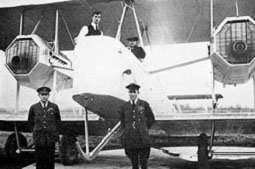Sir Christopher Quintin Brand
World War I air ace touches down in Twickenham
1893 - 1968

Kelly's Directory for 1927 records that Squadron Leader Christopher Joseph Quintin Brand was living at 128 London Road. He was still living there in 1928 and 1929, but had moved away by 1930.
Quintin Brand was born in South Africa on 25th May 1893. He served in the South African defence force from 1914 to 1915, when he developed an interest in powered flight. He transferred to the Royal Flying Corps in England, flying on the western front and in home defence.
Awarded the DSO and DFC in World War I
In September 1917, he and two other officers were granted permission to make the first night-time patrol in single-seater Sopwith Camel fighters, over the Thames Estuary. Previously, only slow two-seater aircraft had been permitted to fly at night and this sortie has been described as 'perhaps the most important event in the history of air defence'.

By May 1918, Quintin “Flossie” Brand was Commander of 112 Squadron. In the last German air raid of the First World War, he brought down one of the three German Gotha bombers which were destroyed that night - an act of heroism that won him the DSO. He managed to escape disaster as the flaming bomber plunged into the sea close by. Shortly afterwards, Gothas were withdrawn from service due to their heavy losses.
On 15th September 1918, he attacked an enemy aircraft over France. His engine's sump was punctured and the windscreen became covered in oil. Despite this, he pursued his opponent, driving it down to 200ft above ground, at which point he was forced to call off the attack. For this, he was awarded the DFC.

Flies from London to Cape Town
After the war, Quintin Brand and Pierre van Ryneveld, another ex-RFC South African, made one of the first flights from Britain to South Africa. Starting from Brooklands on 4th February 1920, they flew their Vickers Vimy bomber, named Silver Queen, to Cairo. They crashed at night near Wadi Haifa in Egypt on 11th February. The two engines were saved and fitted to a new airframe. They continued and reached Bulawayo on the 5th March. Here, when taking-off for Pretoria, the aircraft was destroyed. The South African air force supplied them with a De Havilland DH9 and they landed in Cape Town on 20th March. Both pilots were subsequently knighted.
From 1925 to 1927, he was Senior Technical Officer, then Principal Technical Officer, at the Royal Aircraft Establishment at Farnborough. It was during this time that he moved to the London Road house. In 1929 he left Twickenham when he was posted to Abu Qir (Aboukir) in Egypt, and was then appointed Director-General of Aviation in Egypt from 1932 to 1936.
World War II: commands 10th Fighter Battle Group
In 1940, after the outbreak of World War II, he was promoted to Air Vice Marshal by Air Chief Marshal Sir Hugh Dowding and assumed command of 10 Fighter Battle Group, responsible for the defence of south-west England and South Wales. He supported his peer officer, Air Vice Marshal Keith Park, in advocating the use of small, rapidly deployed, groups of fighters. The opposing strategy, supported by other officers including Douglas Bader, involved assembling complete squadrons before attacking enemy aircraft. In October 1940, Fighter Command was reorganised, Dowding and Park were relieved of their commands and Brand was transferred to command a training group. He retired in 1943.
He married Marie Vaughan in 1920, but she died in 1941. Brand married her sister Mary in 1943, living in Surrey until 1952, when they moved to Southern Rhodesia. Quintin Brand died on 7th March 1968.
References:
Oxford Dictionary of National Biography, May 2006 Version
Kelly's Directories 1925-1932
The Times, Obituaries, 10th March 1968



